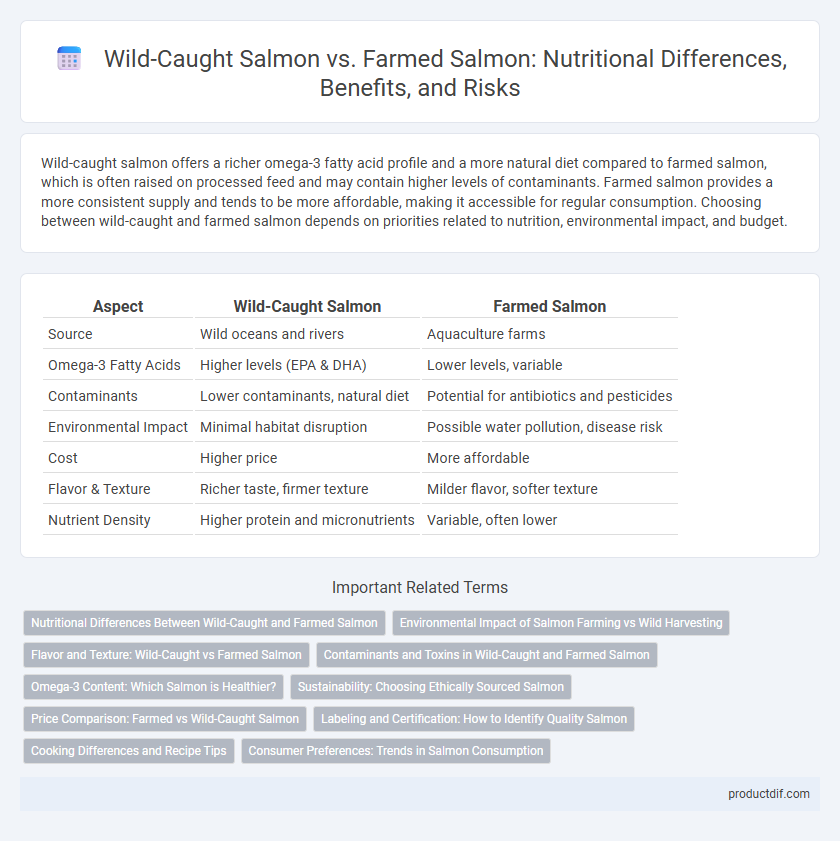Wild-caught salmon offers a richer omega-3 fatty acid profile and a more natural diet compared to farmed salmon, which is often raised on processed feed and may contain higher levels of contaminants. Farmed salmon provides a more consistent supply and tends to be more affordable, making it accessible for regular consumption. Choosing between wild-caught and farmed salmon depends on priorities related to nutrition, environmental impact, and budget.
Table of Comparison
| Aspect | Wild-Caught Salmon | Farmed Salmon |
|---|---|---|
| Source | Wild oceans and rivers | Aquaculture farms |
| Omega-3 Fatty Acids | Higher levels (EPA & DHA) | Lower levels, variable |
| Contaminants | Lower contaminants, natural diet | Potential for antibiotics and pesticides |
| Environmental Impact | Minimal habitat disruption | Possible water pollution, disease risk |
| Cost | Higher price | More affordable |
| Flavor & Texture | Richer taste, firmer texture | Milder flavor, softer texture |
| Nutrient Density | Higher protein and micronutrients | Variable, often lower |
Nutritional Differences Between Wild-Caught and Farmed Salmon
Wild-caught salmon generally contains lower levels of total fat and calories compared to farmed salmon, with approximately 6-8 grams of fat per 3-ounce serving versus 10-15 grams in farmed varieties. Omega-3 fatty acid content, particularly EPA and DHA, tends to be higher in wild-caught salmon, enhancing its cardiovascular benefits. Farmed salmon may have elevated levels of omega-6 fatty acids and contaminants due to feed differences, impacting their overall nutritional profile.
Environmental Impact of Salmon Farming vs Wild Harvesting
Wild-caught salmon harvesting supports natural ecosystems by maintaining biodiversity and producing minimal pollution, but it faces challenges like overfishing and habitat disruption. Salmon farming, although supplying large quantities of fish, often results in water pollution, disease transmission to wild populations, and habitat degradation due to overcrowded pens and chemical use. Sustainable aquaculture practices and stricter regulatory frameworks are essential to mitigate environmental damage associated with farmed salmon production.
Flavor and Texture: Wild-Caught vs Farmed Salmon
Wild-caught salmon offers a richer, more complex flavor with a firmer texture due to its natural diet and active lifestyle. Farmed salmon tends to have a milder taste and softer, fattier flesh because of controlled feeding and less movement. These differences significantly impact culinary uses, with wild-caught preferred for dishes highlighting texture and bold flavor.
Contaminants and Toxins in Wild-Caught and Farmed Salmon
Wild-caught salmon generally contains lower levels of contaminants such as polychlorinated biphenyls (PCBs) and dioxins compared to farmed salmon, due to their natural diet and environment. Farmed salmon often exhibit higher concentrations of these toxins as a result of feed ingredients and crowded farming conditions. Consumers concerned about contaminants should prioritize sourcing wild-caught salmon from reputable fisheries with strict environmental monitoring.
Omega-3 Content: Which Salmon is Healthier?
Wild-caught salmon contains higher levels of omega-3 fatty acids EPA and DHA compared to farmed salmon, offering greater heart and brain health benefits. Farmed salmon often has increased fat content but may contain lower concentrations of essential omega-3s due to diet variations. Choosing wild-caught salmon provides a more potent source of omega-3s crucial for reducing inflammation and supporting cardiovascular health.
Sustainability: Choosing Ethically Sourced Salmon
Wild-caught salmon generally offers a more sustainable option due to natural habitats and minimal human intervention compared to farmed salmon, which often involves intensive resource use and environmental concerns like pollution and disease spread. Ethically sourced salmon emphasizes responsible fishing or farming practices that ensure population health, habitat protection, and reduced carbon footprint. Consumers prioritizing sustainability should seek certifications such as MSC (Marine Stewardship Council) or ASC (Aquaculture Stewardship Council) when selecting salmon.
Price Comparison: Farmed vs Wild-Caught Salmon
Farm-raised salmon typically costs 30-50% less per pound compared to wild-caught salmon due to lower production expenses and higher availability. Wild-caught salmon prices fluctuate seasonally and regionally, often reaching premium levels during peak fishing seasons and in specialized markets. Consumers pay a premium for wild-caught salmon driven by its perceived superior flavor, nutritional profile, and sustainability benefits.
Labeling and Certification: How to Identify Quality Salmon
Wild-caught salmon often carries certifications such as MSC (Marine Stewardship Council), indicating sustainable and traceable sourcing, while farmed salmon may display labels like ASC (Aquaculture Stewardship Council) to ensure responsible farming practices. Look for clear labeling that specifies origin, species, and certification details to identify quality salmon and verify its environmental and health standards. Certification logos and transparent supply chain information on packaging provide reliable indicators of salmon quality and sustainability.
Cooking Differences and Recipe Tips
Wild-caught salmon features a firmer texture and richer flavor, making it ideal for grilling or pan-searing to enhance its natural taste without overpowering seasoning. Farmed salmon tends to have higher fat content, which provides a buttery consistency suitable for baking, smoking, or poaching to retain moisture and tenderness. When preparing wild-caught salmon, use minimal oil and simple herbs like dill or lemon, while farmed salmon benefits from stronger spices and marinades to balance its milder flavor.
Consumer Preferences: Trends in Salmon Consumption
Consumer preferences in salmon consumption increasingly favor wild-caught salmon due to perceptions of superior taste, higher omega-3 fatty acid content, and environmental sustainability. Market trends reveal a growing demand for sustainably sourced seafood, with buyers prioritizing wild-caught options that are free from antibiotics and artificial additives often associated with farmed salmon. Despite higher costs, wild-caught salmon maintains strong appeal among health-conscious consumers seeking natural, nutrient-rich protein sources.
Wild-Caught Salmon vs Farmed Salmon Infographic

 productdif.com
productdif.com